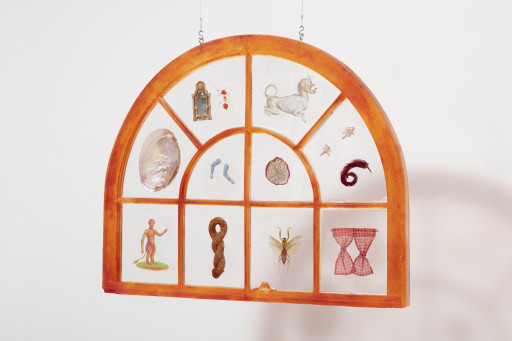In her solo show Here Be Dragons, Sula Bermúdez-Silverman continues her exploration of colonial myth-making, particularly how scientific and historical fact can be falsely constructed, distorted, and come to occupy a space of authority over indigenous knowledge production. Looking to explorers of the “New World” in 15th-17th centuries, many of whom had never set foot on the continents now known as The Americas, fantastical myths begin to emerge, including the existence of entirely new races of people—each described more monstrously than the next. The era of expansion was more than just the discovery and seizure of foreign land, it also included the subjugation and indoctrination of non-Western people. The authority of science has often been used to rationalize cruelty. The power of the myth itself can supersede humanity.
Following her previous handling of sugar and glass, the artist uses resin to provide a powerful agent for sealing together elements that do not easily bind. Suspended in liquid stillness are pearls, drawings, insects, tobacco, peppers, beans, and other materials with deep colonialist histories. Every object is researched extensively, with Bermúdez-Silverman compiling pages of notes that detail the complexities of trade mapping, scientific observation, sailors’ travelogs, and naturalists’ drawings and journals. These lunettes model a vitrine of curiosities that in turn, question the high authority of institutions such as the scientific academy and Western religion. Bermúdez-Silverman sources all the objects she casts from the internet—another frontier of discovery and domination, creating experts out of scores of fanatics, zealots, and well-meaning hobbyists.
Unlike a falsely worded Wikipedia entry, however, the documents and illustrations that survived their journey to the New World with its mystical lands, creatures, and faces are far more difficult to reclaim or redact. Instead, upon these myths, Western civilization has staked its claim and created a foundation of persistent belief in the ‘fearsome Other’; and on this basis, has produced centuries of genocide, slavery, and disease. Bermúdez-Silverman describes reading these explorers’ notes and documents as an exercise of deciphering a game of “telephone” with each traveler picking up some piece of where the other left off.
In Here Be Dragons, Sula Bermúdez-Silverman aesthetically toys with the whimsy, adventure, and imaginative in “New World” tales, while reminding us how fantasy, when seated uncomfortably within structures of racialized capitalist power, becomes corrosive, genocidal fact.
— Elena Gross





